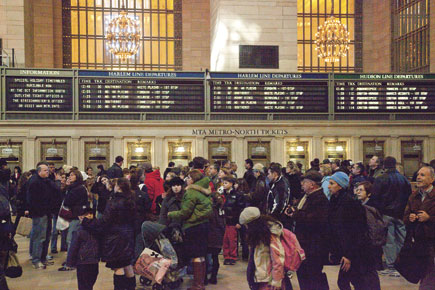Canon’s EOS 5D Mark II; HD Videos And 21MP “Full-Frame” Stills Page 2
Video In A D-SLR
Live View gets the full treatment on the 5D Mark II, even in full HD Video mode. Setting up for video is easy—follow the straightforward directions in the instruction book and go into the menu and select Stills+Movie then hit the Live View button on the upper left of the camera back, then hit the Select button and you’re shooting. You can zoom as you work as well, a nice touch given all the optical options Canon and third-party lens makers afford. However, I got a bit of a herky-jerky playback on my Mac G5 via QuickTime in HD recording; this was not evident in the standard 640x480 mode. I played these back on my standard TV via the camera (a very easy procedure with supplied cables, HDMI cables sold separately) and the HD videos were fine. I did fiddle with various preferences and settings on the G5 to eliminate the condition, but could not. Research shows this might not be an unusual occurrence via computer, and Canon might need to issue some sort of directives about how to eliminate this. I requested same, but none were forthcoming as we went to press. Again, I claim little knowledge on the video side but according to some video sites I have researched on the web, the opinion is that “controls need to be opened up on the video side.” I can report that if you shoot in a quiet space you will hear the camera “gurgling” a bit on the soundtrack as it does its operations, but an external mic would solve this.
ISO 25,600 |
|
 |
|
 |
|
|
The great thing is that you can shoot stills when using the Movie mode without having to switch out from one to the other. The still does interrupt the movie by about a second, which resumes after the hiatus (they do not record simultaneously) and is stored in a separate file. When I downloaded stills and movies from the same card the movies were located at the “bottom” of the file stack in Bridge for CS4 all together, and not in sequence with the stills. And the camera does offer an HDMI output for watching the images on a relatively new TV.
Naturally there is a rush to get even more features and quality in the Video mode on D-SLRs and we haven’t heard the last of this trend yet. I can see myself using it for the occasional birthday party or trip clip, but there’s a reason I shoot stills and not videos. I am sure there will be at least a dozen D-SLR video websites up and running by the time you read this.
Auto White Balance |
|
 |
|
|
AF Performance
The Live View mode sports both Quick AF (nine plus six AF points) with some blackout when exposure is made, and Live AF using contrast detection and an AF box that can be moved around the image frame. (Note, however, that AF speed is still faster when you use the optical finder.) The diamond-shaped array of nine AF points does enhance both vertical and horizontal focus coverage tracking, aided by six “invisible” supplemental AF Assist Points. All can combine with the center AF point to increase its size when tracking fast-moving subjects, a real boon for those shooting sports and other events. You can also program the camera/lens combo to fine-tune focusing with many Canon EF lenses. I’ve never had any complaint with Canon’s delivery of fast, quiet, and accurate focusing and the 5D Mark II continues this fine tradition.
High ISO
One of the most startling features of late is this flirting with super-high ISO ratings, and though I am sure folks who do surveillance or similar work will bask in ISO 25,000 (OK, 25,600 to be precise), most will find it a very occasionally useful feature at best. However, there’s no doubt that shooting at 3200 and even 6400 will find some uses and the results are very good. What is most impressive are the filtering algorithms designed to work at these high sensitivities. (Tech note #3: I am given to understand that high Noise Reduction (NR) filtration offers benefits when working in hot environments as well, which apparently increases noise even at more common ISO settings.) The only time the evocation of a High NR setting will affect your shooting is when you are going for a high framing rate, as the excessive processing of these images tends to slow things down.
Highlight Tone Priority |
|
 |
|
|
Field Tests
My tests with the camera included interior shooting to play with the higher ISO settings, contrasty conditions to check out the Highlight Tone Priority and Auto Lighting Optimizer Custom Functions, and some general knock-around shots to get a feel for operation. One of the first things I did was to separate focus from exposure functions, which you do by taking the camera off Evaluative metering pattern and putting the exposure lock into the shutter release and the AF operation into the AF “on” button on the back of the camera. The point is that like all Canon cameras in this class, and many below, setting up the camera to behave exactly how you want to work is easy, a tradition Canon established many moons back in their advanced film SLR cameras. This camera is built for those who know how they like to work and who will not put up with impediments to their degree and level of customization. That includes creating your own shooting modes and registering them to call upon when desired, a wonderful use of the programming capability of a D-SLR.
I shot all images in raw+JPEG (small) to take advantage of the 14-bit quality; I opened images in Adobe Camera Raw (Version 5.2 for the 5D Mark II is available for CS4, but do take note that it is not available for CS3 and below, so supplied Canon software might be the way to go) and chose the 16-bit option at 300dpi and was rewarded with 120MB files (about 60MB in 8 bit) that literally jumped out of my Apple Cinema Display. As I do with many digital images, I applied sharpening at about 120 percent and have to say that the crisp and clear images on screen were startling. While some might need larger files, I have to say that 60MB 8-bit or 120MB 16-bit files will handle 99 percent of the tasks I put images to, and that stock, wedding, candid, travel, portrait, and any photographer who wants excellent image quality will find this camera’s output more than meets their needs.
Of course this has to do with the “full-frame” chip and the efficiency of light gathering it affords, as well as the DIGIC 4 processor, which seems to be supremely capable of handling all that information with speed and class. That really comes into play at the higher realms of ISO, which as mentioned at H2 go up to 25,600 in this camera. I shot quite a few images at this sensitivity and was frankly amazed at the quality, especially when using the Strong NR option. Yes, it cuts back a bit on edge sharpness, but not as much as I am used to and frankly better than I have yet seen. Noise at this speed was quite apparent upon enlargement, and without the supplemental noise reduction applied is quite a bit more so. But c’mon folks—ISO 25,600? Having shot and pushed the best that high ISO slide films had to offer there’s no doubt that this is a decided digital advantage. Frankly, I would never use as high an ISO setting as this in “real life,” but it’s there for those who want it. The Highlight Tone Priority and Auto Lighting Optimizer also work as expected, and their tech aspects have been covered in these pages (see the Canon EOS 50D review on www.shutterbug.com via the Search box).
Indeed, the 5D Mark II ($2699, retail) might in many ways be regarded as a 50D ($1399, retail) in 5D clothing, at least in terms of handling, but that difference becomes greater when you consider the larger sensor, megapixel count, and of course video capability and stronger body heft, weight, and build. But is there enough of a difference to make you go out and spend the extra bucks for the 5D Mark II? What about the EOS-1Ds Mark III ($7999, retail)? Canon does make a distinction between the 5D Mark II and EOS-1Ds Mark III in that the III is, and I quote, “…built to higher pro standards and includes a vertical grip and shutter release.” But the 5D Mark II does offer a more advanced processing engine, which pays dividends when in super-high ISO territory, video capability, and more, and by the way sells for $5000 less. Kind of a no brainer there for most of us, at least in my book. But that 5D/50D tossup is a bit less straightforward, and I think that video capability, and of course the full-frame sensor, is the deal maker or breaker for us all. But don’t let the video feature make up your mind, as I am sure that this D-SLR feature, being so well received, can only improve in the future.
For more information, contact Canon U.S.A., Inc. at: www.canonusa.com.
- Log in or register to post comments

































